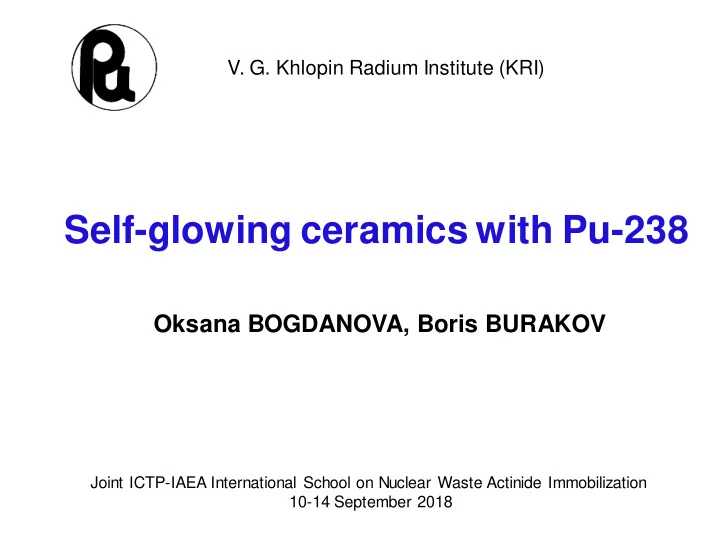

V. G. Khlopin Radium Institute (KRI) Self-glowing ceramics with Pu-238 Oksana BOGDANOVA, Boris BURAKOV Joint ICTP-IAEA International School on Nuclear Waste Actinide Immobilization 10-14 September 2018
Development of self-glowing radionuclides- doped materials with durable crystalline matrices opens new environmentally safe applications of actinides “ Nuclear ” electric batteries might be developed Current will not be high, but enough to feed modern electronic devices during dozens and even hundreds of years under conditions of space and aggressive media 2
Self-glowing of highly radioactive materials is well known phenomenon History of industrial application of natural Ra started in the beginning of 20 th Century from the production of glowing paints. 3
Most of radioactive glowing sources developed in the past consist of several separate parts: 1) Non-radioactive crystalline material doped with non- radioactive luminescence ion (for example, ZnS doped with 3+ Eu) 2) Highly radioactive material (for example, 238 PuO 2 ) 3) Hermetically sealed body (made of steel and transparent G. A. Mihalchenko glass) “ Radioluminescent emitters ” , 1988 4
We suggest to combine all three parts in one durable crystal matrix We have to develop durable low-radioactive ceramics with intensive self-glowing 5
The first stage is to define a durable crystal matrix 6
Why we choose cubic stabilized zirconia? ✓ High chemical resistance ✓ Mechanical durability (hardness above quartz) ✓ Stability under irradiation ✓ Becomes electrically conductive when heated ✓ Matrix for waste disposal ✓ This matrix can include different elements (actinides and non-radioactive luminescent ions) in a wide concentration range 7
The second stage is to define the optimal concentration of luminescence ion (responsible for the highest intensity of luminescence) 8
Difficulties in determining the optimum concentration of luminescent ions ✓ Too high or too small content of luminescence ion(s) will cause weak self-glowing ✓ The optimal contents of luminescence ion are different for different crystalline host phase ✓ It is requiring multiple experiments So the optimal concentrations of luminescent ions are defining for non-radioactive samples 9
Determination the optimal concentration of the phosphor in the solution of Eu(NO 3 ) 3 Optimal Suboptimal Water concentration of Eu concentration of Eu The laser beam ( 532nm ± 10nm) passed through the water and the solution of Eu(NO 3 ) 3 10
Single-phase ceramic based on (Zr 0.82 Y 0.18-x Eu x )O 1.91 (x = 0,01 - 0,10) in normal light luminescence in the ultraviolet 11
Single-phase ceramic based on (Zr 0.82 Y 0.18-x-y Eu x Tb y )O 1.91 (x = 0,02 – 0,10; y = 0,0005; 0,01; 0,015 и 0,02) 12
The third stage is to syntesize ceramic doped with a relativly small amount of actinides (up to 0.1 wt. %) 13
Scheme of the synthesis of ceramics ZrO(NO 3 ) 2 Y(NO 3 ) 3 Eu(NO 3 ) 3 filtering and calcination at co- Tb(NO 3 ) 3 pressing of drying at temperature precipitation pellets temperature 600 ˚C in air 200 ˚C in air synthesis of ceramics (1500 ˚C, 3 hours) Single-phase ceramics based on (Zr 0.82 Y 0.18-x Eu x )O 1.91 and (Zr 0.82 Y 0.18-x-y Eu x Tb y )O 1.91 14
Grinding the mixture into a mortar Sintering in air inside glove-box at temperature 1500 ⁰ C inside glove-box 15 Glove-box Our working group
Self-glowing ceramics based on (Zr,Y,Eu)O 2 and (Zr,Y,Eu,Tb)O 2 doped with Pu-238 Eu – 9,4 масс.% Eu – 9,4 масс.% Eu – 9,4 wt.% Eu – 9,4 wt.% Eu – 10,8 wt.% Tb – 1,4 wt.% Tb – 1,4 wt.% Tb – 1,4 масс.% Tb – 1,4 масс.% Pu – 0,1 wt.% Pu – 0,1 wt.% Pu – 0,5 wt.% Pu – 0,01 масс.% Pu – 0,5 масс.% 16
Conclusions This research can help to create environmentally friendly advanced radioactive glowing crystalline materials and improve the understanding of the behavior of actinides in ceramic matrices are promising for the disposal of radioactive waste
Recommend
More recommend